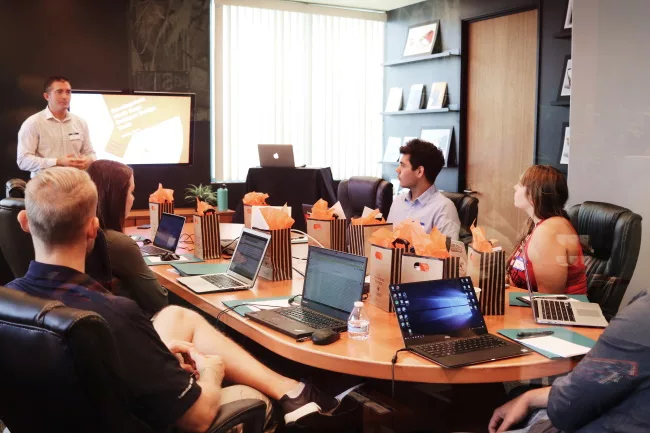
We’ve talked about the many reasons why nonprofit events are a great fundraising strategy. But running successful fundraising events is not easy. Nonprofits need a strong framework to pull off a successful fundraising event. Creating an effective nonprofit fundraising committee is most often the first step to success.
Create an Effective Framework for Fundraising Ideas

Nonprofits utilize specific leadership structures to maintain their 501c3 tax-exempt status. Typically, that structure includes a Board of Directors. The board should be a guiding force, that provides strong leadership and fundraising functions. Therefore, it’s vital that a board’s leadership creates the environment for effective committees within the organization.
One of the nonprofits’ most important—and busiest—committees will be the fundraising committee. If the nonprofit is big enough, one fundraising committee will oversee smaller committees that work on specific fundraising event ideas.
Here are six steps to building effective committees for fundraising events.
Create a Welcoming Environment for Volunteer Committee Members
Every committee team member should feel like they are a vital part of the action being planned. Use these welcoming tips to motivate volunteers:

- If you feed them, they will come! There’s nothing like a light snack to entice committee members, maybe a bowl of popcorn, pretzels, fruit, or candies. Munchies create a welcoming environment.
- Make listening to each other a priority; all fundraising ideas are worth pursuing.
- Work within agendas so everyone understands expectations.
- Provide small gifts for your initial meeting. A good example is an inexpensive notebook, personalized with names. Tie a marker or two to the binder wire with a ribbon. Members can decorate their notebooks, adding the titles of their committee jobs.
Discover Individual Strengths and Use Them
As important as it is to listen to members’ ideas, it is just as vital to utilize individual strengths. Assign “people persons” as community liaisons. If someone is uncomfortable with money—don’t put them in charge of event budgeting. If someone takes over the discussions during meetings, put him or her in charge of organizing ideas on a whiteboard; that requires a refocus upon listening and organization. Here are a few other ideas to match committee members’ strengths to committee needs:
- Survey self-perceived skills to start. An online search using keywords “volunteer skills questionnaire” produces multiple templates.
- From motivation comes action. Tap into that motivation and each person will feel fulfilled by their part in the fundraiser.
Organize Effective Meetings

There is nothing worse than wasting time through ineffective meetings. Meetings are the place where everything pulls together through effective communication.
- Begin early in the planning process so that a schedule for all meetings, including sub-committees can be set. A schedule means people can plan to attend. When they can’t, they can get someone to communicate with or take notes for them.
- Always have an agenda. Use email to send each agenda out in advance, allowing time for replies to add items. Send last-meeting minutes with the agenda. Meetings will go faster if members include short written reports with the agenda.
- Use software to make your walk-a-thon, golf outing, or other fundraiser easier.
- Meeting success is not determined by length, but by how much gets done. Let the little stuff be communicated quickly. Make sure the next-step planning and assignments are the focus of each meeting.
Make Committee Meetings Fun!
You expect your fundraising event to be fun. If not, why would anyone participate? That fun starts with the planning committee. The work is important, but fun motivates, encourages, and creates an environment for success.

- Have gifts ready for a drawing at some meetings. This needn’t be expensive. Set a rotation for each member to bring a small gift for each meeting. These gift ideas could be small personal items, gag gifts, or even white elephant items.
- Have meetings in fun places. Restaurants are good, but picnics might be better. Remember, if you feed them, they will come.
- Even if you meet at your nonprofit’s office, the area can be made fun. Have some music playing to set the tone.
- If you’re planning an ongoing fundraiser, show videos or a picture board from previous years in order to keep the fundraiser’s end goal as a focus. Besides, it’s always fun to look at old pictures and videos.
Stay on Task

Even the strongest committee that has fun during meetings must keep the end goal in clear focus. The Amish community has a saying, “Many hands make light work.” Use these ideas to help you ensure a profitable fundraiser:
- Make sure your committee is large enough, but not too large. Fewer motivated volunteers can also get the job done.
- Allow your committee members to create sub-committees that have very specific tasks.
- Make sure that the during-planning tasks match the day-of fundraiser tasks.
- Experience counts! Utilize those who have former experience with specific tasks for the current fundraiser.
- Public Relations is always one of the most important ongoing sub-committees.
- Fundraiser participants won’t remember public relations, only the day-of-event activities. Make sure that things are well-organized, focused, targeted, and fun. You want participants to come back next time—with their friends!
Wrap-Up the Fundraiser Well
The committee’s job is not done when the fundraiser is over. Be sure to get everyone together within a week of the event, when the event is still fresh in everyone’s mind. Honor the planning committee’s effort with a celebration. More than a t-shirt, a celebration proclaims hard work spent for a common cause.
- Celebrations equip committee members with the motivation to help with your future fundraisers.
- Celebrations provide the committee leaders an opportunity to evaluate the fundraiser’s success. What did you do well? What can be improved? Suggesting changes to improve the next fundraising event is key.
- Create upcoming steering committees at the celebration.
If there is one rule of nonprofit funding it is this: The end of one fundraiser is just the beginning of the next one. Fundraising is a year-round venture for most nonprofits. Committee work never stops; using these strategies will ensure that new leadership arises within the organization. Remember, too, fundraisers don’t just happen, they are grown through hard work and shared-mission motivation.


![How to Start A Nonprofit 501(c)3 Org. [10 Step Guide] How to Start A Nonprofit 501(c)3 Org. [10 Step Guide]](https://www.dojiggy.com/files/sites/164/2019/03/How-to-Start-A-Nonprofit-501c3-Org-10-Step-Guide-423x282.webp)
